|
MobileDemand xTablet Flex 8
Intel "Bay Trail" quad-core powered 8-inch Windows 8.1 capacitive multi-touch tablet in a custom-designed, preinstalled protective case costs less than an non-rugged iPad mini 3
by Conrad H. Blickenstorfer
MobileDemand launched the xTablet Flex 8 late 2014 as the third in a series of thin and light rugged tablets the company released during the year. The "business-loaded" xTablet Flex 8, a smaller companion product to the xTablet Flex 10 introduced earlier in 2014, is designed to deliver productivity improvements to the increasingly wide-ranging set of customers who require more ruggedness than consumer-grade tablets can deliver, but at a price that is not prohibitive.
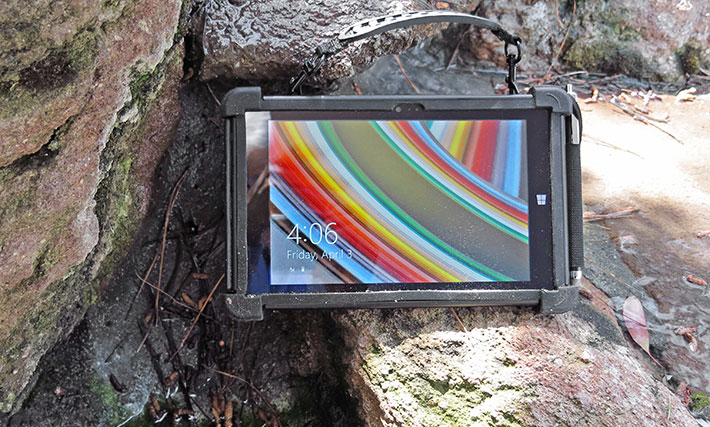
With its xTablet Flex line, MobileDemand does that by pre-packaging and assembling what is essentially a standard, albeit fully loaded, consumer/business Windows tablet with a competent protective case with bumpers and a carry handle, a scratch-proof screen protector, and other touches and implements essential to a rugged device. So instead of searching for a case that may or may not do the job, buyers get a tablet with a comprehensive, heavy-duty case designed by experts in rugged Tablet PCs. And what does this cost, the whole package? US$595 with Windows 8.1, and US$745 with Windows 8.1 Professional. To put that in perspective, the Microsoft Surface 3 with 128GB, an Atom x7-Z8700 chip and Windows 8.1 is US$799. And a 128GB iPad mini 3 is $599. Which means the price is right there.
That price-conscious approach means that with the xTablet Flex 8, MobileDemand is entering new territory. Ever since the iPad legitimized the tablet form factor, which is now selling by the hundreds of millions, rugged tablet vendors have struggled to successfully participate in the bonanza. First it was older rugged tablet technology that buyers — spoiled by sleek, speedy procap media tablets — were reluctant to accept, then it was the price. Even many high-profile enterprise buyers bought inexpensive consumer tablets and stuck them in a case. If they broke, they simply replaced them. There is considerable debate in the rugged industry as to whether it's a good idea to put consumer tech in a case. Well, MobileDemand obviously decided to find out for itself.
But first, in accurate scale, let's see where the xTablet Flex 8 (left) fits in compared the larger xTablet Flex 10 (middle left), the company's higher-end thin & light xTablet T1400 (middle right), and the older fully rugged T7200 (right) that has a wide-format 7-inch screen.

Side-by-side, the size and design differences become obvious. And each product clearly fills a purpose and need.
MobileDemand's Flex platform
While MobileDemand introduced both Flex tablets as well as the T1400 during 2014 as part of MobileDemand's new line of thin and light rugged tablets, there's is a fundamental difference between the two lines. The T1400 was designed and built as a cohesive rugged tablet with significant performance and capabilities, whereas with the Flex 8 and Flex 10, making ruggedized packages available at the lowest possible price was the primary objective.
To make that possible, MobileDemand sourced a more or less generic tablet that met the company's features and performance goals, custom-designed a protective rubber boot with thick bumpers to cradle that tablet, and that assembly then goes into a sturdy polycarbonate backplate. The picture below shows the three components, the tablet itself, the backplate, and the rubber boot:
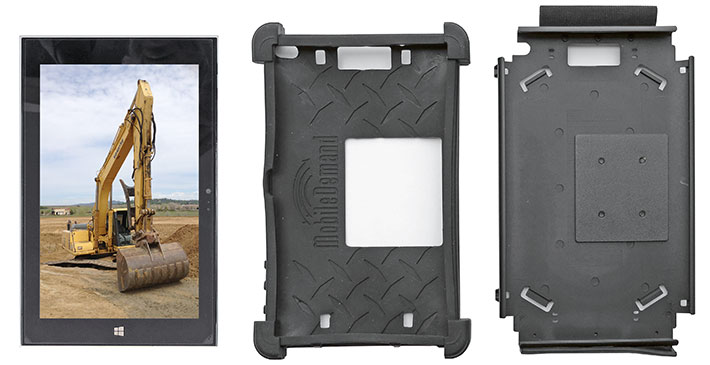
Do note that what protects the xTablet Flex 8 is far more than just your standard after-market case. Calling it part of the overall concept and design of the Flex 8 would not be an overstatement. Most users will probably never even take the tablet itself out of its armor.
But cladding the tablet with hefty protection wasn't all MobileDemand did; they also designed the backplate to accommodate a briefcase carrying handle, a heavy duty hand strap, and an easily accessible holster for the unit's capacitive stylus. All of this is included in the price. Customers ordering an xTablet Flex 8 will receive the unit exactly as shown in the pictures below.
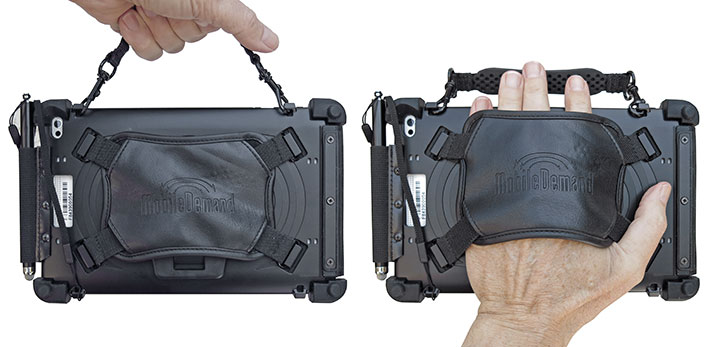
What differentiates the xTablet Flex 8 from buying a tablet and then a case for it is that it all comes preassembled and the case was designed by a company that has vast experience in rugged tablets. And there's an additional piece of protection that isn't visible in the pictures above: the xTablet Flex 8 also comes with a pre-applied screen protector that's not just the usual aftermarket sheet of plastic but scratch-proof material with a special oleophobic (fingerprint-resistant) coating. According to MobileDemand, it improves impact resistance by 20% — much welcome extra protection.
Below is a look at the xTablet Flex 8 from the front and from all four sides. We photoshopped out the hand strap on the backside of the tablet to better show just how thin and compact this tablet is even inside its case.
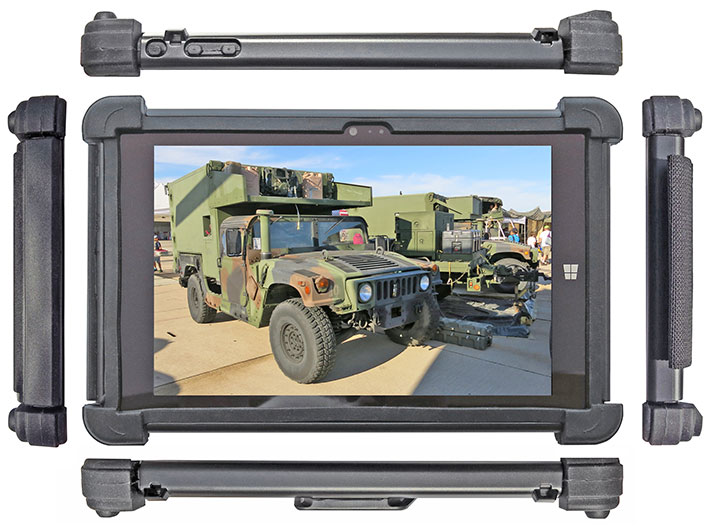
In these pictures the xTablet Flex 8 looks almost indistinguishable from a regular rugged tablet where the protection is an integral part of the design. In actual use the difference is more pronounced as the protective boot is made of very soft rubber so that it can be pulled over the tablet.
The below picture shows a close-up of the left side of the xTablet Flex 8, both with and without the protective case and boot. The picture shows how slender the base tablet is.

Note that in the upper picture we photoshopped off the soft protective rubber plug that covers all I/O on the left side of the tablet.
As far as I/O goes, from left to right, there is a small microphone hole, a micro USB port that's used for charging the tablet, a micro HDMI port, the micro SDHC/SDXC card slot, then the blue USB 3.0 port and a regular USB 2.0 port, both full size, and finally a standard 3.5mm audio in/out jack.
What we especially appreciate here are the two full-size USB ports, as they are significantly less prone to damage than the tiny and flimsier micro slots and connectors of any kind. The latter are sized to fit into phones and other small devices, but they really shouldn't be used in their present form in anything rugged.
Intel "Bay Trail" processor
Computing power comes from a 1.46GHz quad-core Intel Z3770 processor that can reach burst speeds up to 2.4GHz. It belongs to Intel's next-gen "Bay Trail" platform. The Bay Trail CPU architecture employs 22nm process technology and is a major advance in Atom microprocessor design, the first since the platform arrived a few years ago. 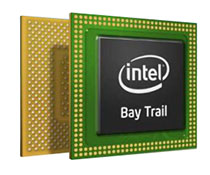 Note that turbo boost is called "burst frequency" in the Bay Trail lineup, and that an implementation of the clever power-saving "active idle" feature from Haswell core processors is apparently there as well. Note that turbo boost is called "burst frequency" in the Bay Trail lineup, and that an implementation of the clever power-saving "active idle" feature from Haswell core processors is apparently there as well.
That said, the Bay Trail processor platform is somewhat confusing as it includes not just Atom but also Celeron and even Pentium branded chips. The N2920 used in MobileDemand's xTablet T1400 is sold by Intel as a Celeron whereas Intel lists the Flex 8's Z3770 as an Atom. Both are quad-core chips with Intel HD Graphics and, according to their specs, are quite evenly matched. For full Z3770 specs, see Intel's Z3770 product sheet.
While even detailed examination of Intel's literature provides few clues as to what the relevant, real-world differences are between the various Bay Trail processor lines, it does appear that Intel views the Z-Series for lower cost tablets and perhaps even smartphones, whereas the significantly more costly N-Series is for higher end tablets.
|
PassMark 6.1
|
MobileDemand
|
MobileDemand
|
MobileDemand
|
|
Model
|
xTablet Flex 8
|
xTablet Flex 10
|
xTablet T1400
|
|
OS
|
Win 8.1 (32-bit)
|
Win 8.1 (32-bit)
|
Win 8.1 (64-bit)
|
|
Processor Type
|
Intel Atom
|
Intel Atom
|
Intel Celeron
|
|
Processor Model
|
Z3775
|
Z3770
|
N2920
|
|
CPU Speed
|
1.46Hz
|
1.46Hz
|
1.86Hz
|
|
Max Burst Speed
|
2.39Hz
|
2.39Hz
|
2.00Hz
|
|
Scenario Design Power (TDP)
|
2.0 watts
|
2.0 watts
|
4.5 watts
|
|
CPU Mark
|
1,589.5
|
1,590.9
|
2,014.7
|
|
2D Graphics Mark
|
178.2
|
179.8
|
153.1
|
|
Memory Mark
|
421.1
|
412.8
|
409.9
|
|
Disk Mark
|
288.0
|
294.4
|
2,048.3
|
|
3D Graphics Mark
|
147.4
|
127.3
|
115.3
|
|
Overall PassMark
|
605.2
|
603.2
|
1,062.7
|
|
CrystalMark
|
|
|
|
|
ALU
|
29,126
|
30,027
|
26,714
|
|
FPU
|
24,532
|
18,413
|
22,541
|
|
MEM
|
25,540
|
22,904
|
16,411
|
|
HDD
|
10,649
|
10,634
|
36,655
|
|
GDI
|
5,582
|
5,793
|
4,816
|
|
D2D
|
3,527
|
3,216
|
3,335
|
|
OGL
|
3,454
|
3,366
|
3,207
|
|
Overall CrystalMark
|
102,4123
|
94,353
|
113,679
|
Another irritating development is that Intel has started to use SDP ("Scenario Design Power") instead of the more common TDP ("Thermal Design Power"). TDP indicates the maximum amount of heat in watts a system's cooling must be able to remove, giving a pretty good indication of the chip's overall performance, whereas SDP is the amount of heat to be removed under benign conditions, i.e. standard tablet apps and no temperature extremes. "Burst speed," likewise, is just the speed the processor may reach under ideal conditions. We take this as meaning that if things get hot, the chip slows down.
On the plus side, the graphics cores integrated into Bay Trail systems are of the same HD 4000 architecture and variety as those used in Intel's 3rd generation "Ivy Bridge" processors, albeit with fewer execution units (four instead of several times that number) and lower clock speeds. Still, that means the new graphics support most of the same APIs and features, including DirectX 11, OpenGL 4.0, and OpenCL 1.2.
As is, the table to the left shows our benchmark results for the Z3770-based xTablet Flex 8 and Flex 10 and the N2920-based xTablet T1400. MobileDemand told us their own benchmarks showed the higher-end T1400's CPU performance about 20% better than the Flex 8's, with 2D graphics about 15% better and 3D graphics 7-10% better. Our own numbers agreed on the CPU, but the Flex 8 more than held its own in memory and graphics performance. The Flex 8 has a small performance advantage in graphics-related benchmarks over the Flex 10; that's probably because the smaller unit has fewer display pixels to move around.
There's one area where the Flex models' benchmark numbers came up short, and that's disk. The reason is that the higher-end T1400 uses high-performance SSD (solid state disk) with a high-speed mSATA interface whereas the economy Flex models use eMMC (similar to memory cards and USB sticks). Both are flash storage, but the controllers and chips used in SSDs are faster and much more sophisticated. As a result, the Flex systems score much lower in disk performance, enough to put a significant gap in overall performance between them and the T1400.
That's not to say, however, that the Flex 8 is slow. In fact, MobileDemand's low-cost tablet feels quick and snappy in everyday use.
Power consumption: amazingly low
For battery life, we didn't expect all that much from a 8-inch tablet with a miserly but rather powerful Intel processor and a battery of just 17.5 watt-hours, less than even the iPad mini 3's downsized (compared to the mini 2) battery, and considerably less than the Flex 10's 29 watt-hour battery.
We used the PassMark BatteryMon utility to examine power draw under different settings. We discovered that the Windows Power Settings control panel, which usually allows you to select from various power settings, in the Flex 8 was limited to "Balanced." The explanation in the Windows Help panel was that this was because of the system's InstantGo (see Wiki on InstantGo) that allows systems to wake up instantly from sleep with apps and data up to date.
When running the drawdown test, with the tablet's backlight set to its dimmest, we saw an amazingly low 2.8 watts (compared to the Flex 10's 3.2 watts). With the backlight in normal indoor setting, that rose to 3.4 (3.7) watts and with the backlight at its maximum, it rose to 4.1 (5.7) watts.
2.8 watts is the lowest power draw we've ever seen in our lab. If the unlabeled battery indeed provides 17.5 watt-hours as the specs claim, that would translate into a theoretical 6.25 hours of battery life. Even with the backlight on full bright, it would still mean 4.25 hours until a full battery is completely drained.
Real world battery life, of course, greatly varies depending on usage patterns. But one thing is for sure: between the Intel Z3770 chip and the tablet's design and setup, at least in benchmark testing, the Flex 8 is very power-efficient (and extremely so for an Intel-based design).
MobileDemand's own estimate in the product specs is 4.5 hours, and that should be possible.
Superb IPS 1280 x 800 pixel capacitive multi-touch display
While the Flex 8's mass storage makes performance concessions in the quest for maximum affordability, the display definitely does not. Measuring a compact but not too small 8 inches diagonally — it's noticeably larger than the 7-inch screen of MobileDemand's workhorse xTablet T7200 — and it offers perfectly suitable WXGA resolution. That's 1280 x 800 pixel in 16:10 wide-format — 30% more pixel that the 1024 x 768 XGA format commonly used in rugged tablets (even ones with larger screen sizes) for many years.
On a 8-inch tablet screen, that means 190 dots per inch (dpi), which means it's sharper than, say, Dell's terrific 24-inch UltraSharp 4k monitor, and much sharper than the original iPad. The xTablet Flex 8 uses 10-point projected capacitive multi-touch for effortless tapping, panning, pinching and zooming, plus executing whatever complex operations need more than just a few fingers. And the bright display is of the IPS (in-plane switching) variety that makes for perfect viewing from all angles.
MobileDemand supplies a capacitive pen with a foot-long lanyard. The pen is of the passive capacitive variety and has the broad tip that works well for tapping and panning, but not for precision work. To MobileDemand's credit, they replaced the usually short and chintzy generic capacitive pens with their rubber tips with a metal mesh tipped stylus that's more durable, works somewhat better, and is longer and thicker than generic styli. And they also used their standard and very durable tether and stylus holder to store the pen when it's not in use.
We tried handwriting recognition with it, and it works remarkably well. Ink goes on much better than on resistive digitizers, but not as well as on a Wacom style active digitizer.
Ruggedness
Here it gets interesting. The Flex 8 tablet itself is consumer-grade, but, neatly protected inside its rugged case, it can actually survive the MIL-STD-810G 26 drops from four feet onto concrete. With the tests performed on one single unit while it's operating. That's impressive.
MobileDemand says that you can also drop an 8-ounce steel ball from a meter onto its screen and it won't get hurt due to the special screen protector (we didn't try that!).
The operating temperature range is narrower than for MobileDemand's fully rugged gear, but 32 to 120 degrees Fahrenheit should cover most business users' needs (albeit not if it involves freezers or outdoor use in nordic climates).
Despite its protective casing and nicely implemented protective rubber plug for all I/O ports, the Flex 8 isn't considered a sealed unit and does not have an IP rating. That means no working in the rain. However, the special coating on the screen protector makes water perl off.
The video clip to the right shows some of the "torture chamber" tests MobileDemand subjects the larger Flex 10 to.
In MobileDemand's own words, "the rugged case has two layers for drop protection. The first layer is rubber with bumpers similar to what you see on other fully rugged MobileDemand tablets. The second layer is a high impact polycarbonate case that holds the rubber layer in place, but also provides mounting details for critical user carrying accessories including a back hand strap, a briefcase handle, a stylus holder, I/O door cover, and a MiFi pouch."
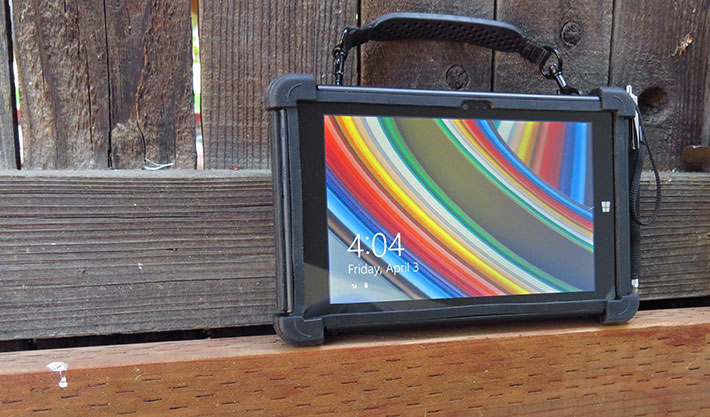
So, again, while the xTablet Flex 8 looks like a fully rugged device, it is a consumer tablet inside a very intelligently designed case system. It can handle a lot more abuse than any sleek consumer tablet, but it is not a sealed unit and it is not designed for use in truly harsh and unforgiving environments.
Mounting options
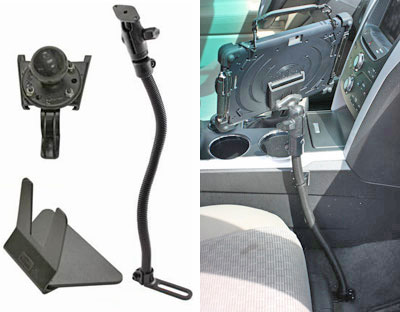 Most tablets used in business or on the job come with some kind of docking and mounting options, and the Flex 8 and 10 units are no different. While MobileDemand does not offer the full office and vehicle docks available for most of its higher end tablets, its "snap mount" system has two kit options: Most tablets used in business or on the job come with some kind of docking and mounting options, and the Flex 8 and 10 units are no different. While MobileDemand does not offer the full office and vehicle docks available for most of its higher end tablets, its "snap mount" system has two kit options:
The standard kit uses a B-ball with a no-drill base. The picture to the right shows the no-drill base with the ball already installed, with the diamond shaped 2-hole mount.
The heavy duty kit uses the C-ball with the typical AMPs pattern, also shown to the right.
The Snap Mount supports both hole patterns, with the 4-hole/C-ball mount providing the best solution for high vibration implementations like forklifts, semis, garbage trucks, etc. This allows also customers to use any RAM-Mount implementation.
Bottom line: MobileDemand xTablet Flex 8
With the new MobileDemand xTablet Flex tablets, the company breaks new ground by combining modern, competent Windows 8.1 media tablets with a specially designed and preinstalled elaborate case that provides very respectable ruggedness. 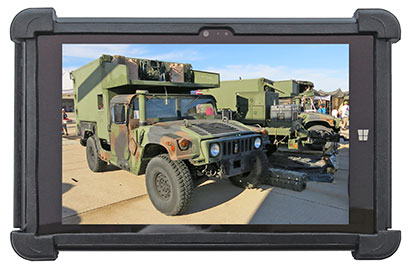 To get this much performance in an impressively well protected package from a well-established provider of rugged tablet computers for so little money is nothing short of amazing. The whole xTablet Flex 8 package, including the industrial-grade briefcase carrying handle and heavy duty hand strap, costs less than an iPad mini 3! To get this much performance in an impressively well protected package from a well-established provider of rugged tablet computers for so little money is nothing short of amazing. The whole xTablet Flex 8 package, including the industrial-grade briefcase carrying handle and heavy duty hand strap, costs less than an iPad mini 3!
Weighing just 1.6 pounds including case, handle and hand strap (that's no more than a bare original 3G iPad weighed!), MobileDemand's innovative "thin-and-light" tablet package offers a new answer for customers who seek the convenience, low cost and ease of use of a sleek consumer media tablet in something that's better protected and doesn't cost anywhere near as much as a fully rugged (or even semi-rugged) tablet.
The Flex 8's quad-core Intel "Bay Trail" processor yields impressive performance, the kind available only from Intel Core-powered (and more expensive) devices just a couple of years ago.
The low cost might one lead to expect low-end components and performance, but the xTablet Flex 8 impresses with an very sharp, bright and vibrant display that offers well-matched 1280 x 800 pixel resolution, a perfect viewing angle from all directions, and no color shifts. Its 10-point capacitive multi-touch screen is quick and very responsive, and works well with Windows 8.1 and touch-optimized applications. The included capacitive stylus has the usual broad tip, but it's of the metal mesh variety and works quite well.
For an inexpensive thin-and-light tablet the Flex 8 has good onboard connectivity, including both USB 3.0 and USB 2.0 ports, and micro-HDMI. The 2mp and 5mp cameras offer consumer tablet performance (i.e. quite good).
Inside its excellent rubber and polycarbonate casing, the xTablet Flex 8 is very well protected and appears to be able to handle a significant deal of abuse. It is not sealed, however, and the operating temperature range of the tablet is not quite as wide as that of fully rugged tablets.
Offering good performance, exceptionally low power draw, a very good display, and surprising ruggedness, the fanless xTablet Flex 8 represents a compelling, and compellingly priced, package for anyone who needs Windows on tough jobs that don't require the higher protection (and cost) of a fully rugged device.
That said, the very low cost also means some compromises. Unlike the company's T1400 rugged tablet, the Flex 8 does not offer Windows 7, is not sealed, does not have a replaceable battery, does not offer a scanner (nor RFID or GPS), and mounting options are more limited. If that doesn't matter, the xTablet Flex 8 (or its smaller Flex 10 sibling) may well fit the (surprisingly small) bill.
-- Conrad H. Blickenstorfer, April 2015
MobileDemand xTablet Flex 8 Specs:
| Type |
Thin-and-light rugged Windows Tablet PC
|
| Added |
Added 11/2014, full review 05/2015
|
| Processor |
Quad-core Intel Bay Trail Z3775
|
| Processor speed |
1.46GHz, 2.39GHz burst frequency
|
| Scenario Design Power |
2 watts |
| Display Chipset |
Intel HD Graphics |
| OS |
Windows 8.1 Professional or Windows 8.1 with Bing |
| Memory |
4GB LPDDR3-1066 |
| Display |
IPS LCD with 235 nits LED backlight |
| Display size/res |
8-inch, 1280 x 800
|
| Digitizer |
OGS (One Glass Solution) 10-point capacitive multi-touch/capacitive stylus |
| Keyboard |
Optional external keyboard
|
| Storage |
64GB eMMC |
| Expansion slots |
1 x micro SD, 1 x USIM |
| Housing |
Plastic tablet housing inside rubber glove with protective rubber bumpers, polycarbonate case, and briefcase handle |
| Size |
8.8 x 5.6 x 0.7 inches (224 x 141 x 18mm)
|
| Weight |
1.6 lbs. with case, handle, hand strap, and capacitive stylus |
| Operating temperature |
32° to +120°F (0° to +49°C) |
| Ingress protection |
Not rated
|
| Drop/shock |
MIL-STD 810G, 516.6 IV: 26 repeated drops to one operating unit onto plywood over concrete from 48 inches |
| Tumble |
1,000 one-meter tumbles (simulates 5 years worth of drops and tumbles)
|
| Vibration |
Accelerated extreme truck and forklift vibration testing, 21G peak acceleration, 10 to 1,000Hz (6 hour test simulates intense forklift vibration extremes and a total of 100,000 miles at 55mph on average US roads)
|
| Power |
Internal non user-replaceable Li-Ion 17.5 watt-hours ("4.5 hours") |
| Cameras |
2mp camera front, 5mp camera with LED flash rear (up to 2592 x 1944 pixel) |
| Sensors |
Light, G-sensor, Gyroscope, e-Compass
|
| Interface |
1 x USB 2.0, 1 x USB 3.0, 1 x micro-HDMI, audio, power, docking |
| Wireless options |
802.11a/b/g/n, Bluetooth 4.0, MiFi options for WWAN
|
| Price |
US$595 With Windows 8.1 with Bing, US$745 with Windows 8.1 Pro ??? |
| Warranty |
1 year limited warranty
|
| Contact |
MobileDemand xTablet Flex 8 web page |
(copyright 2015 RuggedPCReview.com)
|




